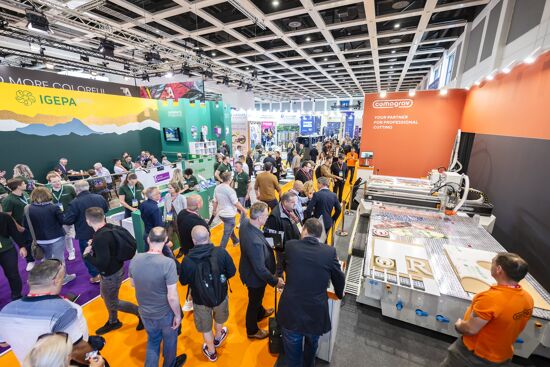ISO Standards Update in 2019
.png?width=750)
Laurel Brunner discusses how printing and environmental impact mitigation have had a long and controversial history.
On the one hand there are still too many people who dish the industry as an environmental hooligan. On the other there is the basics of why print is a such a sustainable industry: recycling, efficiency, print on demand and process automation all ensure that print is a sustainable industry sector. Print media products have a onetime environmental impact and there are no emissions generated when they are used. This is in stark contrast to the considerable emissions associated with electronic media, from email to gaming.
ISO’s environmental standards have played a part in print’s improved environmental impact, although the need to compete and to offer value added services to print buyers has played a bigger role. The advent of open systems created an extremely competitive environment for traditional developers building bespoke and highly proprietary technologies. Prepress was a controlled and protected preserve, which made it especially vulnerable to the disruption that standard platforms and operating systems brought. Going direct to plate and subsequently direct to press, took further processes, costs and chemicals out of production, removing their related environmental aspects in the process.
ISO standards for cutting impacts
The role of ISO standards has been to standardise processes in order to deliver even more process efficiency. Many printing companies are certified for compliance to ISO 14001 for Environmental Management Systems. This document provides a framework for continual improvement in environmental aspect and impact quantification and mitigation.
Efforts within ISO technical committees to improve and make accountable the overall environmental impact of print have produced several worthwhile documents, despite concerted efforts by vested interests to prevent progress. ISO 16759 for instance outlines requirements for carbon footprint calculations for individual print runs. It specifies the requirements for working out the carbon footprint of all processes, technologies and materials used to produce a print media product, based on the information available to the user. The idea is to look at the processes and materials involved in producing print, and to quantify them and their carbon footprint in a meaningful way.
The implementation of ISO 16759 is not restricted to any particular print sector, so it is relevant for all wide format digital print media production as well as offset and gravure. If you are working on a particular wild format project and you want to know its carbon footprint, ISO 16759 can help you to work it out.
There are a couple of other ISO standards developed within the group responsible for ISO 16759. ISO 20294 for calculating the carbon footprint of electronic media is a companion document to ISO 16759. It was developed so that the carbon footprints of the two media types can be fairly compared.
ISO 20690 outlines how to go about working out the energy consumption of a digital printing device, particularly high speed devices designed for long runs. There is a similar document that is perhaps more interesting within the wide format digital printing community. ISO 21632 explains how to measure the electricity usage for machines that have lots of stops and starts. The idea with both ISO 21632 and ISO 20690 is to provide a basis for like-for-like comparisons when looking to buy or use the most energy efficient production digital press.
Process control, efficiency, emissions and waste reduction
The standards mentioned so far are all specifically for environmental impact mitigation and accountability. However, there are numerous data and process control related standards that arguably have done more to improve print’s efficiency and resource usage. Standards such as PDF (ISO 32000-2) have made electronic document interchange a commonplace, and PDF and the PDF-X series have been important drivers in the move to soft proofing and electronic document approvals. Much of this type of activity takes place on the computer screen rather that with hard copies which means a substantial cut in the number of consumables and transport used to get proofs approved.
.png?lang=en-GB)
Caption: Standards are important. It’s unlikely that the carbon footprint for the printing of this snowboard was calculated. But it is highly likely that the printing data was delivered to the service provider as a PDF.
The development of the PDF/X series (ISO 15930) is especially relevant for process control and efficiency, leading to waste reductions in the printing sector. This collection of standards has been evolving for many years, with new versions introduced with every update to PDF. The most recent documents are all based on PDF 2.0 introduced in 2017.
PDF/X specifications restrict what a PDF can contain so that it will pass through prepress checking and into production without halts. This facilitates automation and ensures that the PDF will print as expected, so it also cuts out the need for additional proofing cycles. Which version of PDF/X you choose to use depends on the technology your print service provider is using and the complexity of your job. If the service provider still works with an older version of PDF, such as 1.6 or 1.7, this will determine which PDF/X specification you should use. Most relevant for PDF 2.0 processing is PDF/X-6 which supports layers and transparency, and which will have extensions for external graphics, for instance in a variable format print job, optionally including ICC profiles for images. It also allows for the printing of the same job across devices. PDF/X-6 is on track for publication in 2020.
.png?lang=en-GB)
Caption: Keeping track of the data. Standard formats such as CxF (ISO 17972) ensure that data is traceable and can be used in different environments and across different production systems.
Other standards such as ISO 17972, the colour exchange format known as CxF, have improved the exchange of colour data so that we can be much less wasteful in managing document production. ISO 17972 allows you to share colour measurement and metadata electronically and it has several parts. These are organised to work with different workflows, but CxF files can be used in electronic media systems as well.
The eXtensible Metadata Platform (XMP) is another example of how ISO standards for data processing have helped cut waste and so environmental impact. XMP embeds data about content into a document and can be as basic as the date the file was created or extremely complicated. You can transport whole histories of a file for instance right down to when and by whom the file was opened. This makes for very efficient document management and traceability. ISO 16684 is currently undergoing a revision and another version of it is being worked on. This addition will allow for the management of metadata across files, so you could collect all the files relating to an individual or service provider for instance. The writers of this document have high hopes that it will be useful for random content access and aggregation, and for archiving applications.
ISO graphics technology standards are tools for management, processes and products that help businesses to reduce error rates and waste, and to get the most out of the technologies they use, from inks and data through to the press and finishing. Improving print media’s environmental impact is a constant concern for the industry, since it aligns so closely with improving performance and profits. Environmental impact mitigation efforts invariably lead to waste reduction and improved process control.
Source information: The Wild Format guides are intended to expand awareness and understanding of the craziness that can be created on wide format digital printing devices, from floors to lampshades and everything in between. These guides are made possible by Digital Dots with generous support from HP, Techkon and Zünd.
Topics
Interested in joining our community?
Enquire today about joining your local FESPA Association or FESPA Direct
Recent news

Industry Experts Explore the Evolution of Smart Manufacturing in the Textile Industry
A FESPA SmartHUB roundtable at Personalisation Experience 2025 discussed smart manufacturing's transformative impact on the textile industry. Experts highlighted the shift to on-demand customisation, driven by digital printing, data analytics, and automation. Key takeaways included enhanced machine control, significant waste reduction through intelligent software and colour management, and improved sustainability via energy efficiency and near-shoring, ensuring agility and environmental responsibility in textile production.

FESPA 2025 gathers leading visionaries from across the speciality print industry in Berlin
FESPA Global Print Expo 2025, European Sign Expo and Personalisation Experience (6 – 9 May 2025, Messe Berlin, Germany) welcomed Visionaries from across the speciality print industry to shape the future of print, develop forward-thinking business strategies, and explore innovative ways to translate emerging industry trends into tangible growth opportunities.

Exploring Cutting-Edge Textile Printing Innovation with Adobe Print Engine 7
Adobe PDF Print Engine 7, launched at FESPA Global Print 2025, significantly advances textile printing. Debbie McKeegan shares how it automates non-white substrate management and RGB colour handling, expands colour gamuts with in-RIP multicolour transparency blending, and streamlines workflows for efficiency and sustainability. This update boosts customisation, reduces waste, and positions businesses at the forefront of digital print innovation.

FESPA Global Print Expo 2025 - Overall Highlights
FESPA Global Print Expo, Europe's leading print and signage exhibition returned to Messe Berlin from 6 - 9 May 2025.